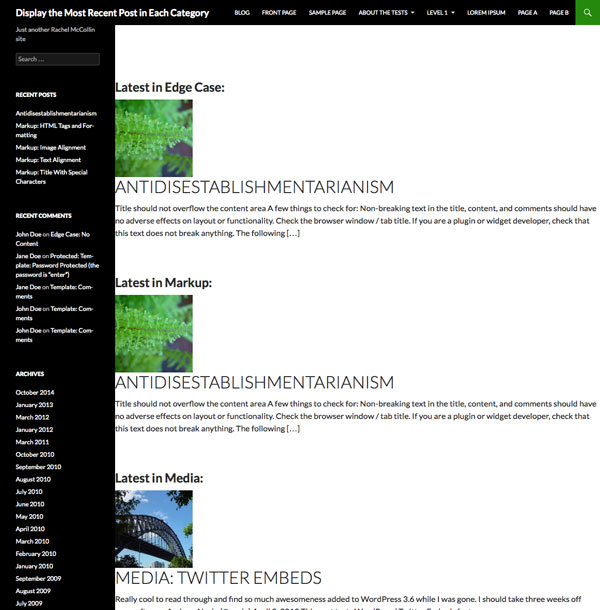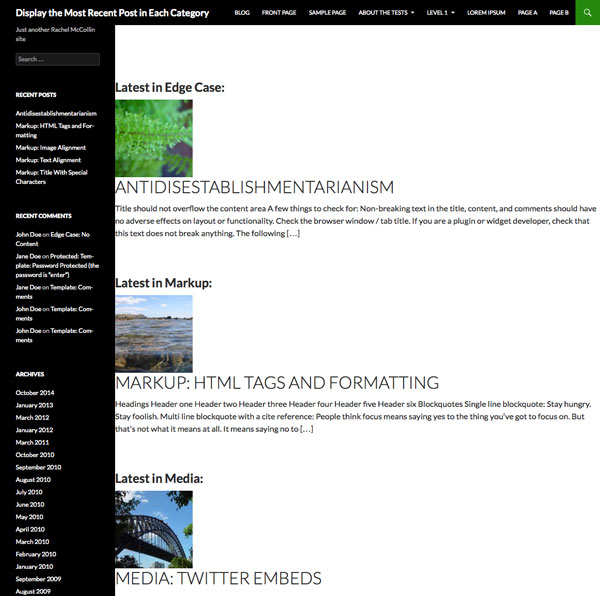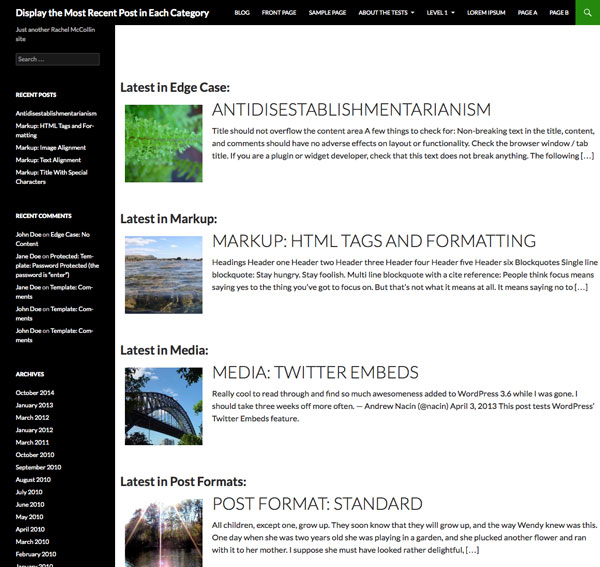每个类别显示最新的帖子
默认情况下,您的 WordPress 主博客页面按日期降序显示您最近的帖子。但是,如果您在网站上使用类别,并且您的读者想要查看每个类别中的新内容,您可能希望您的博客页面看起来有所不同。
在本教程中,我将向您展示如何做到这一点。我将演示如何:
- 识别您博客上的所有类别
- 显示每条帖子的最新帖子,如果帖子有一个,则显示特色图片
- 确保多个类别的帖子不会重复
- 添加一些样式使其看起来不错
您需要什么
要学习本教程,您需要:
- WordPress 的开发安装。
- 已设置一些帖子和类别。我使用了 WordPress 主题单元测试数据中的数据示例。
- 一个主题。我将创建“二十四”主题的子主题。
- 代码编辑器。
设置主题
第一步是设置主题。我将创建“二十四”主题的子主题,仅包含两个文件:style.css 和 index.php。
这是我的样式表:
/*
Theme Name: Display the Most Recent Post in Each Category
Theme URI: http://code.tutsplus.com/tutorials/display-the-most-recent-post-in-each-category--cms-22677
Version: 1.0.0
Description: Theme to accompany tutorial on displaying the most recent post fort each term in a taxonomy for Tutsplus, at http://bitly.com/14cm0yb
Author: Rachel McCollin
Author URI: http://rachelmccollin.co.uk
License: GPL-3.0+
License URI: http://www.gnu.org/licenses/gpl-3.0.html
Domain Path: /lang
Text Domain: tutsplus
Template: twentyfourteen
*/
@import url('../twentyfourteen/style.css');
我稍后会返回此文件来添加样式,但现在 WordPress 只需要识别子主题即可。
创建索引文件
由于我希望我的主博客页面显示每个类别中的最新帖子,因此我将在我的子主题中创建一个新的 index.php 文件。
创建一个空的index.php文件
首先,我将复制 24 中的 index.php 文件,并编辑掉循环和其他内容,使其看起来像这样:
<?php
/**
* The main template file.
*
* Based on the `index.php` file from TwentyFourteen, with an edited version of the `content.php` include file from that theme included here.
*/
?>
<?php get_header(); ?>
<div id="main-content" class="main-content">
<?php
if ( is_front_page() && twentyfourteen_has_featured_posts() ) {
// Include the featured content template.
get_template_part( 'featured-content' );
}
?>
<div id="primary" class="content-area">
<div id="content" class="site-content" role="main">
</div>
</div>
<?php get_sidebar( 'content' ); ?>
</div>
<?php get_sidebar(); ?>
<?php get_footer(); ?>
识别类别
第一步是确定博客中的类别。紧接着打开 <div id="content"> 标签,添加以下内容:
<?php
$categories = get_categories();
foreach ( $categories as $category ) {
}
?>
这使用 get_categories() 函数来获取博客中的类别列表。默认情况下,这将按字母顺序获取,并且不会包含任何空类别。这对我有用,所以我不会添加任何额外的参数。
然后我使用 foreach ( $categories as $category ) {} 告诉 WordPress 依次运行每个类别并运行大括号内的代码。下一步将创建一个针对每个类别运行的查询。
定义查询参数
现在您需要定义查询的参数。在大括号内添加以下内容:
$args = array(
'cat' => $category->term_id,
'post_type' => 'post',
'posts_per_page' => '1',
);
这只会获取当前类别中的一篇帖子。
运行查询
接下来,使用 WP_Query 类插入查询:
$query = new WP_Query( $args );
if ( $query->have_posts() ) { ?>
<section class="<?php echo $category->name; ?> listing">
<h2 id="Latest-in-php-echo-category-name">Latest in <?php echo $category->name; ?>:</h2>
<?php while ( $query->have_posts() ) {
$query->the_post();
?>
<article id="post-<?php the_ID(); ?>" <?php post_class( 'category-listing' ); ?>>
<?php if ( has_post_thumbnail() ) { ?>
<a href="<?php the_permalink(); ?>">
<?php the_post_thumbnail( 'thumbnail' ); ?>
</a>
<?php } ?>
<h3 class="entry-title">
<a href="<?php the_permalink(); ?>">
<?php the_title(); ?>
</a>
</h3>
<?php the_excerpt( __( 'Continue Reading <span class="meta-nav">→</span>', 'twentyfourteen' ) ); ?>
</article>
<?php } // end while ?>
</section>
<?php } // end if
// Use reset to restore original query.
wp_reset_postdata();
这将输出每篇文章的特色图片、标题和摘录,并且每一个都包含在一个链接中。
让我们看看现在的样子:

如您所见,存在问题。我的页面显示每个类别中的最新帖子,但它是重复的帖子,因为有时一个帖子会是多个类别中的最新帖子。让我们解决这个问题。
避免重复帖子
在添加 get_categories() 函数的行上方,添加以下行:
$do_not_duplicate = array();
这会创建一个名为 $do_not_duplicate 的空数组,我们将用它来存储每个帖子输出的 ID,然后检查稍后查询的任何帖子的 ID 是否在其中该数组。
接下来,在查询选项下方添加一个新行,因此前两行如下所示:
<?php while ( $query->have_posts() ) {
$query->the_post();
$do_not_duplicate[] = $post->ID;
?>
这会将当前帖子的 ID 添加到 $do_not_duplicate 数组。
最后,向查询参数添加一个新参数,以避免输出此数组中的任何帖子。您的论点现在如下所示:
$args = array(
'cat' => $category->term_id,
'post_type' => 'post',
'posts_per_page' => '1',
'post__not_in' => $do_not_duplicate
);
这使用 'post__not_in' 参数来查找帖子 ID 数组。
保存您的 index.php 文件并再次查看您的博客页面:

这样更好了!现在您的帖子不再重复。
添加样式
目前,内容有点分散,特色图片位于帖子标题和摘录上方。让我们添加一些样式以使图像向左浮动。
在主题的 style.css 文件中,添加以下内容:
.listing h2 {
margin-left: 10px;
}
.category-listing img {
float: left;
margin: 10px 2%;
}
.category-listing .entry-title {
clear: none;
}
现在内容更适合页面并且布局更好:

使此技术适应不同的内容类型
您可以调整此技术以处理不同的内容类型或分类法。例如:
- 如果您想使用自定义分类术语代替类别,则可以将
get_categories()替换为get_terms()并更改'cat'查询参数来查找分类术语。 - 如果您使用不同的帖子类型,您可以将类似的代码添加到模板文件中,以显示该帖子类型,替换
'post_type' => 'post'参数您的查询参数与您的帖子类型。 - 如果您想在博客主页面中创建一个单独的页面来显示给定分类的任何帖子类型的最新帖子,您可以创建一个分类存档模板并向其中添加此代码的改编版本。李>
- 您可以更进一步,将此技术用于多个分类法或多个帖子类型,使用嵌套的
foreach语句来运行多个循环。 - 您可以将上面的代码添加到您的
single.php页面,以便在帖子内容之后显示每个类别中最新帖子的链接。如果执行此操作,您需要将当前显示页面的 ID 添加到$do_not_duplicate数组中。
摘要
有时,以其他方式(而不是简单地按时间顺序)显示博客上的最新帖子会很有帮助。在这里,我演示了一种技术,用于显示博客上每个类别中的最新帖子,确保帖子在多个类别中不会重复。
以上是每个类别显示最新的帖子的详细内容。更多信息请关注PHP中文网其他相关文章!

热AI工具

Undresser.AI Undress
人工智能驱动的应用程序,用于创建逼真的裸体照片

AI Clothes Remover
用于从照片中去除衣服的在线人工智能工具。

Undress AI Tool
免费脱衣服图片

Clothoff.io
AI脱衣机

AI Hentai Generator
免费生成ai无尽的。

热门文章

热工具

记事本++7.3.1
好用且免费的代码编辑器

SublimeText3汉化版
中文版,非常好用

禅工作室 13.0.1
功能强大的PHP集成开发环境

Dreamweaver CS6
视觉化网页开发工具

SublimeText3 Mac版
神级代码编辑软件(SublimeText3)
 Java实现的提取关键词算法和应用实例
Jun 18, 2023 pm 12:14 PM
Java实现的提取关键词算法和应用实例
Jun 18, 2023 pm 12:14 PM
Java实现的提取关键词算法和应用实例随着互联网时代的到来,海量的文本数据对人们的获取和分析造成了很大的困难,因此需要进行关键词提取等自然语言处理技术的研究和应用。关键词提取是指从一段文本中提取出最能代表该文本主题的单词或短语,为文本分类、检索、聚类等任务提供支持。本文介绍了Java实现的几种关键词提取算法和应用实例。一、TF-IDF算法TF-IDF是一种从
 在Golang函数中实现代码复用的有效方法
Apr 12, 2024 pm 06:12 PM
在Golang函数中实现代码复用的有效方法
Apr 12, 2024 pm 06:12 PM
在Go中实现代码复用有两种主要方法:函数:将重复任务封装在函数中,并在整个项目中重用。包:将相关的代码组织在包中,允许在程序的不同部分重用代码。
 遵循golang函数命名约定有什么好处?
May 04, 2024 am 11:00 AM
遵循golang函数命名约定有什么好处?
May 04, 2024 am 11:00 AM
遵循Golang函数命名约定的好处有:确保函数命名一致,提高可读性。增强可预测性,方便理解函数用途。支持IDE自动补全,节省时间。简化调试,便于隔离问题。
 ECharts词云图:如何展示数据关键词
Dec 18, 2023 am 09:00 AM
ECharts词云图:如何展示数据关键词
Dec 18, 2023 am 09:00 AM
ECharts词云图:如何展示数据关键词,需要具体代码示例引言:随着大数据时代的来临,我们面临的一个重要问题就是如何有效地从海量数据中提取出有用的信息。而关键词的提取就是其中一种常用的方法。在展示关键词时,词云图是一种非常直观且具有艺术性的方式,可以使人们一眼就能快速理解数据的特点和关键词的重要程度。本文将介绍如何使用ECharts来实现词云图的展示,并提供
 探索C语言程序的构成成分有哪些?
Feb 21, 2024 pm 08:21 PM
探索C语言程序的构成成分有哪些?
Feb 21, 2024 pm 08:21 PM
C语言是一种被广泛应用于软件开发和系统编程的高级程序设计语言。它被设计成一种通用的、面向过程的语言,以其简单易学、执行速度快以及可移植性强而著称。C语言有着丰富的构成成分,这些成分相互配合,组成了一个完整的程序。在C语言程序中,最基本的单位是字符和标识符。字符是构成程序文本的最小单位,它可以是字母、数字、符号等。而标识符则是由字母、数字和下划线组成的命名,用
 PHP开发中如何实现百度文心一言随机语句的关键词提取功能?
Aug 26, 2023 am 09:25 AM
PHP开发中如何实现百度文心一言随机语句的关键词提取功能?
Aug 26, 2023 am 09:25 AM
PHP开发中如何实现百度文心一言随机语句的关键词提取功能?百度文心一言是一种随机展示的句子,常用于网站的首页、登录页等地方,电影《你的名字》中也应用了这个功能。而其中的关键词提取功能,可以使展示的句子与网站的内容更加相关,增加用户的阅读体验。接下来,我们将介绍如何使用PHP开发来实现这一功能。首先,我们需要获取百度文心一言的API。在百度开放云平台(http
 自定义golang函数实现的性能优化技巧
Apr 26, 2024 pm 05:09 PM
自定义golang函数实现的性能优化技巧
Apr 26, 2024 pm 05:09 PM
编写和优化自定义Golang函数的技巧对于提升应用程序性能至关重要:缓存函数结果以避免重复计算。使用并发并行执行昂贵的操作。使用指针避免大结构和切片的复制开销。优化循环避免不必要的变量声明和高效的循环构造。利用管道实现并行处理。
 利用 Go 语言的 Rename 函数重命名文件
Apr 08, 2024 pm 02:21 PM
利用 Go 语言的 Rename 函数重命名文件
Apr 08, 2024 pm 02:21 PM
Go语言中的os.Rename函数可方便地重命名文件或目录,更新文件或目录名称而不丢失数据。它需要两个参数:oldpath(当前路径)和newpath(新路径)。该函数会覆盖现有目标,且只能重命名同一文件系统中的文件或目录。






